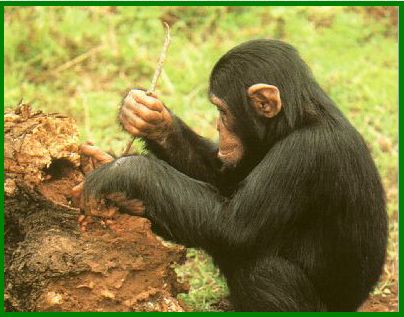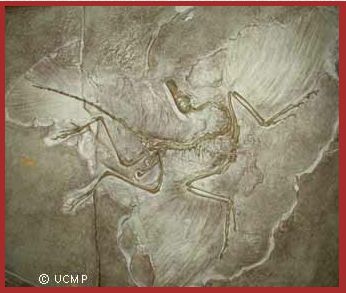 Lesson 3:
Lesson 3:
 The Essence of Life
The Essence of Life
|
 3.7
3.7
 Evolution, the Central Concept
Evolution, the Central Concept

|
 |
Figure 3.7.1
 A young chimp uses a stick as a tool
A young chimp uses a stick as a tool
to reach insects. Humans and chimpanzees share
98% of their DNA.
|
We have seen that Evolution is not some kind of add-on to Life; it is an
integral part of it. Without it, there is no explanation for the Tree of
Life, the observed patterns in the similarities and differences between
the various life forms. Why should it be possible to graft a branch from
an orange tree on that of a lemon tree? Why should a donkey be able to
breed with a horse? Because they are not very far apart, in terms of
their genetic endowment and chemical machinery. Why then should it be
possible to take a gene from a bacterium and insert it into a plant to
make it unpalatable for an insect? Why should the insect be able to
digest the plant in the first place, incorporating molecules produced by
the plant into its own body? Because there is an underlying unity in the
way different life forms conduct their business, on the level of
molecular biology.
The obvious implication for this is common ancestry. It explains why
living things are similar. Linnaeus' classification of plants and animals
opened the path to this realization. The naturalists Jean Baptiste de
Lamarck, Geoffrey Saint-Hilaire (1772-1844) and Leopold von Buch, among
others working around the end of the 18th and in the early 19th century,
realized that common ancestry would make sense of similarities, and a
little later Charles Robert Darwin (1809-1882) provided a mechanism for
evolution in his book on the origin of species, published in 1859.
Darwin's contribution was to introduce the concept of the struggle of
survival in the face of adversity and competition, resulting in the
survival of the fittest, a culling process he labeled "natural
selection." The same idea had occurred to another famous naturalist,
Alfred Russell Wallace (1823-1913), a brilliant eccentric with deep
insights into the rules of biogeography, but who exempted humans from
evolution. Darwin did not.
The use of molecular biology in pursuing the path of evolution is simply
an extension of the earlier approach, based on similarity of anatomy and
morphology, as urged by Geoffrey and Lamarck.

|
 |
Figure 3.7.2
 The evolution of myoglobin can be traced
The evolution of myoglobin can be traced
through its amino acid sequences in different species.
Molecular biology has provided overwhelming evidence
for evolution.
|
Why then, if it is so obvious, is the theme of evolution still in
contention in some quarters? Why do we have school boards meddling in
technical questions of modern biological science and voting on the
teaching of evolution? Can one teach music without reference to the
physics of sound? Can one teach visual arts without reference to color?
Can one teach religion and deny access to holy scripture? Of course not,
unless one makes a mess of it. Neither can one teach biology and reject
evolution, which is the basis for understanding of Life. Evolution
explains why we - all the living things - are still around despite the
great changes that have taken place in the environment of Earth, through
the eons.
There is good reason for taking a deep and abiding interest in matters
surrounding the evolution of Life. Life is the crowning achievement of
the history of the Solar System. It is the most deeply puzzling and
intriguing part of that history. Also, because the study of Life throws
light on our own origin, as humans, such study impinges on our belief
systems, on how we think about ourselves, our place in the scheme of
things. This question, where we belong in the scheme of things, is one
that for thousands of years has been answered by oral religious
traditions, and, since the invention of writing, by written religious
traditions.
Confusion arises when scientific results are interpreted as being in
conflict with such traditional teachings. They are not, where religious
teachings concentrate on ethical behavior and do not presume to provide
textbooks for astronomy, geology, or biology.

|
 |
Figure 3.7.3
 A cast of the fossil remains of
A cast of the fossil remains of
Archeopteryx, believed to be the link
between dinosaurs and modern birds. It is
considered to be one of the most important
fossils ever discovered.
|
The fossil record, despite its gaps, richly supports the concept of
evolution. The earliest period of the existence of Life is forever out
of reach: there are no rocks from that time with preserved information.
Shortly after the end of the "heavy bombardment" period we find chemical
fossils - carbon with a strange isotopic composition. Half a billion
years later we find the first unicellular organisms: including their
small reef-like mounds, the stromatolites. A billion years later we find
clear signs of photosynthetic activity. The oxygen freed in the process
stimulated the rise of eukarya, from collaborating bacterial precursors.
By a billion years ago, eukarya are in full swing, and half a billion
years later they have succeeded in generating pretty much all the
familiar animals, plus many that are not familiar. Land plants start
shortly after. Three-hundred million years ago we see the first
reptiles. From there to birds and mammals is but a small step. Five
million years ago the human ancestors split off from the ancestor of
chimps, and since then we have learned to climb less, run more, and use
our brain, which has since greatly increased in size.
Schematic of the evolution of life since its origin more than 4 billion
years ago. On the right side is a blow-up of geologic history of the
last 500 million years, one ninth of the total age. This period contains
rocks with fossils of large multicellular organisms, including corals,
trilobites, cephalopods, fishes and reptiles.
Using the brain for modeling the solar system makes us unique among all
the life forms. Although bees model the path of the Sun across the sky
(to tell time and direction) they do so, presumably, without the
faintest idea of the nature of the Sun.
|





















